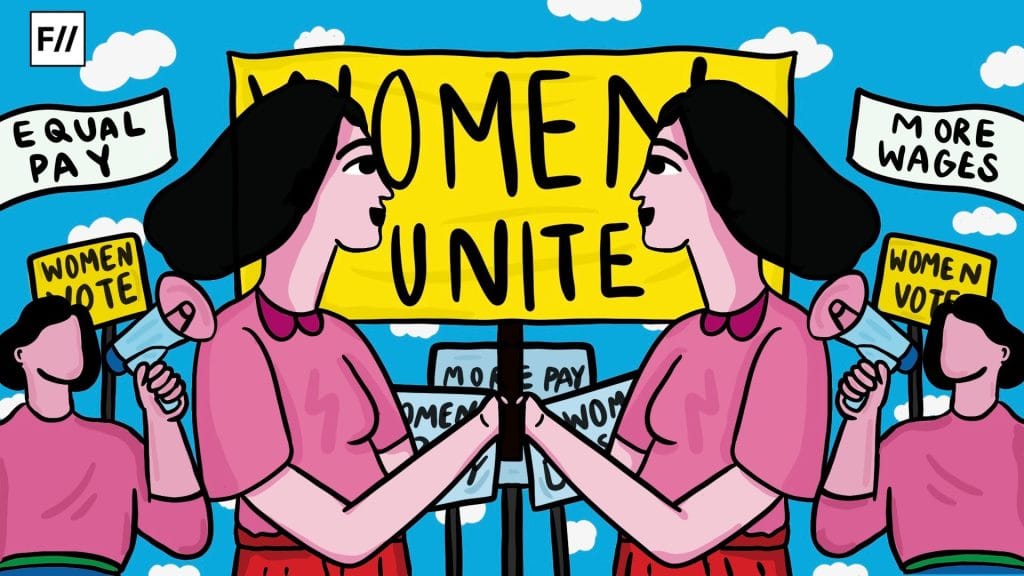Women have lost out on salaried jobs in India down to an all-time low in the past 7 years, reveals data in the Periodic Labour Force Survey (July 2023-June 2024). The survey released early this week by the National Sample Survey Organisation (NSSO) under the Ministry of Statistics and Programme Implementation indicates a shift in employment patterns from salaried jobs to self-employment, lower pay, and a deteriorating environment for work among Indian workers. Even though the country’s income growth is observing an increase than expected for this year, the workforce ratio remains skewed.
Women are looking for jobs, but aren’t getting one.
According to the Survey, the female labour force participation which indicates the number of women looking for jobs, has risen to its highest level this year (41.7 per cent). However, the unemployment rate amongst women has also starkly increased to 3.2 per cent from 2.9 per cent (2022-23). This indicates that while women are interested and willing to do paid work, they are not getting jobs. Even for men in India, the unemployment rate is high. However, it has dropped to a small but significant 0.1 per cent since the previous report.

Any rational person would wonder that unprecedented economic growth post-liberalisation, not to mention higher education rate, and comparatively radical changes in mindset would automatically result in more women in paid jobs but the opposite has happened. The number is only low. Around 50 lakh jobs were lost in the country post-demonetisation, per the Status of Working in India Report of Azim Premji University (2016-18). It also revealed how women were much worse affected by the consequences of the policy through loss of job opportunities. Then came COVID, and things got worse. As reported by IndiaSpend, eight months after the COVID-19 lockdown was imposed, 13 per cent fewer women than a year before were employed or looking for jobs in the country as compared to 2 per cent fewer men.
Low workforce participation in both urban and rural women
Urban women saw the deepest losses during covid especially migrant women. The migrant women in urban areas not only had to leave their jobs but were struggling to return home after the imposition of a strict and abrupt nationwide lockdown as announced by the Prime Minister. Women in Urban India are comparatively much less employed than men in Urban India. The worker-population ratio which indicates the percentage of people in a population who are employed, shows only 20.7 per cent of Urban women as part of the workforce. This number is significantly low as compared to their male counterparts (59 per cent). What does this indicate? Are women in Urban India not being hired or are facing longer spells of joblessness? Is the traditional patriarchal division of labour with the man providing and the woman taking care of the household rampantly engrained within urban households? Or is it the work culture in Urban Indian economies that makes it difficult for women to find work or continue working where they already do?

For women who are employed, many work in informal sectors or part-time roles. Wage disparities persist, and there is an ongoing concern about job security and opportunities for career advancement. Moreover, even though the radicalisation of mindset has happened women’s workload has only increased in the past decade. After long hours of paid work at offices, women are still expected to do all the unpaid household chores in most Indian households. The death of EY Pune’s employee recently has brought attention to the intense work pressures faced by young professionals in India. The employee’s mother attributed her daughter’s death to overwhelming “work stress” in a letter addressed to the firm’s Chairman.
Long working hours, no work-life balance, tight deadlines toxic work culture are a dangerous part of a larger systemic issue that is supposed to be solved in our country. The case also intensified discussions around the severe workloads young professionals endure, particularly young women in male-dominated fields. While male CEOs of multinationals continue to glorify ‘70-hour work weeks,’ they fail to realise how overworked and underpaid Indian workers already are, especially women who are supposed to answer questions like ‘what’s for dinner,’ even after a long work shift.
Toxic work culture is no biggy in India by now, take the case of Bombay Shaving Company CEO’s obnoxious post on Linkedin; in which he asks freshers to ‘work 18 hours a day and stop cribbing.’ According to him, you are not supposed to do any ‘rona dhona’, because that’s what they expect people to give in, their all.
Fewer females in the paid economy
Before, we delve into debunking some questions it is important for us to first realise how women have always worked and still do, even more than men. However, the undervaluing of a woman’s work and lack of proper capturing of women’s work by such surveys is to be considered first. While performing these surveys, are we considering who is being asked the survey questions, for example, if a woman assists her husband at the family farm or business, does she or her husband think of her as employed even when she is?

A report from The Hindu highlights these loopholes in such surveys, especially national ones. Enumerators often speak to whosoever is present there at that time in the household. This methodological flaw may not be relevant for studying more conservative groups and regions in India. It is pretty obvious for the man in such communities or groups to answer on behalf of everyone. Due to this, women’s work may go underreported. Even so, these methodological loopholes do not guarantee the reasons behind a lack of accuracy in the results shown.
For women, the motherhood penalty is also an added why. In urban areas, people may think as the income is higher, there is no necessity for the woman to also earn as the man already manages to earn enough. This could be another reason why. Especially for urban women’s lesser participation in the workforce. Rural Women have other challenges apart from the ones that persist universally for women irrespective of their locality. Rural regions are observing a shift from agriculture to secondary and tertiary jobs but the infrastructure, and commuting services are still lagging badly in the region.
Status of women’s employment in different socio-religious groups
Women from marginalised castes and religious groups often face discrimination while getting or performing their jobs at their workplaces. Reaching the top ladder of the hierarchy in a male-dominated space is an even harder nut to crack. Historically, people from the lowered castes have been expected to engage in manual and domestic work irrespective of their gender. While men were expected to do heavy manual labour, women helped with domestic work in upper-caste households. Even as per ‘The India Employment Report 2024,’ the SCs are predominantly employed in agriculture and construction work with their representation in manufacturing, and service sectors comparatively lower. When studying patterns of employment in religious groups, even though Christians are the third largest religious community in India, the labour and workforce participation of Christian women continues to remain the highest. This can be attributed to a larger literacy rate among women in the community.
However, the same analogy didn’t apply to the women while studying their rate of employment based on the rural-urban demographics. For Muslim women, even though higher participation has been observed in rural areas when compared to the previous report, there is still a huge gap in the employment status of urban Muslim women. It is important to note that overall women’s participation in the workforce is continuing to increase but the rate of incline is quite low and almost stagnant. With young women struggling to get jobs, finding odds in meeting ends meet to manage dreams, financial independence and household chores, the government should make workplaces a healthier space. Authorities should focus on creating more job opportunities in the market. Instead of, making lousy statements on ‘inner strength,’ and ‘divinity,’ the concerned authorities in the country should focus on building a healthy work culture. They should address challenges faced by employees especially gender and sexual minorities at workplaces. All women work, but only some are paid. Hence, every woman’s work should be valued in the country.
About the author(s)
As an independent journalist, writer, and aspiring documentary filmmaker, Stuti covers about social and political issues. Interested in development journalism she also highlights issues on human rights, gender, education, unemployment, law and others. She aims to start her own news media initiative in the future to transform the way development is covered and discussed in the news.





